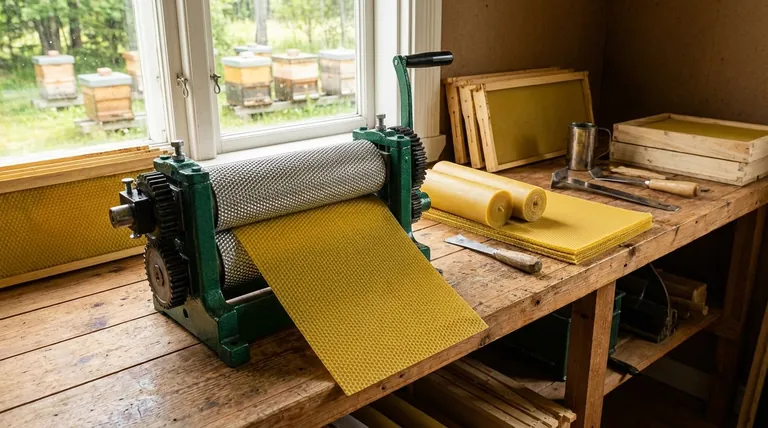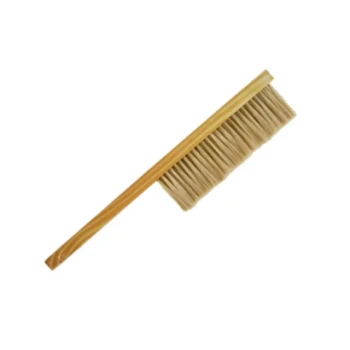In essence, wax foundation is a starter sheet for honey bees, imprinted with the hexagonal pattern of a honeycomb. Beekeepers place these sheets inside the frames of a hive to provide the bees with a guide, or foundation, upon which they can build their own wax comb for storing honey and raising young.
The core purpose of wax foundation is not merely to give bees a starting point, but to direct their natural building instincts. This guidance creates straight, uniform, and removable combs, which is the foundational principle enabling modern, efficient beekeeping.

The Problem: Unmanaged Comb Construction
To understand the value of foundation, you must first understand what happens without it. Bees are master architects, but their goals are not always aligned with the beekeeper's.
The Challenge of "Cross Comb"
Left to their own devices in an empty space, bees will often build their wax comb across multiple frames, attaching them together. This is known as cross comb or burr comb.
This natural construction makes it impossible for a beekeeper to remove a single frame for inspection. Trying to pull one frame out will tear the comb, kill developing bees (brood), and spill honey, which can trigger robbing behavior from other hives.
The Inefficiency of Wild Build
Creating beeswax is an incredibly energy-intensive process for a honey bee. It is estimated that bees consume 6-8 pounds of honey to produce just one pound of wax.
When bees must build the entire comb structure from scratch, they divert a massive amount of energy and resources away from other vital tasks, namely foraging for nectar and pollen.
How Wax Foundation Improves the Hive
Wax foundation is a simple invention that elegantly solves these core problems, benefiting both the bees and the beekeeper.
Guiding Construction for Easy Management
The imprinted hexagonal pattern on the foundation sheet acts as a blueprint. The bees instinctively follow this guide, building their comb straight and neatly within the confines of a single frame.
This ensures every frame in a movable-frame hive can be removed, inspected, and replaced individually. This is critical for monitoring colony health, checking for pests like Varroa mites, and assessing food stores.
Conserving Bee Energy for Higher Productivity
By providing the base structure, wax foundation gives the colony a significant head start. The bees do not have to expend as much energy producing the initial wax.
This conserved energy is then reallocated to foraging. The result is a more productive colony that can build up its population and store surplus honey more quickly.
Ensuring Structural Integrity
Comb built on a foundation is stronger and more stable. This is especially important during honey extraction.
Full frames of honey are spun in a centrifuge to remove the honey. The foundation acts as a strong backbone, preventing the delicate comb from blowing apart under the intense rotational force.
Understanding the Trade-offs
While foundation is the industry standard, it is not the only approach. Acknowledging the alternatives is key to making an informed decision.
The "Natural" Approach: Foundationless Beekeeping
Some beekeepers prefer to let bees build their own comb from scratch within an empty frame, often guided by just a small strip of wood or wax.
The primary benefit is that the bees control the size of the hexagonal cells, which some believe is more natural and can help with pest resistance. The downside is a much higher likelihood of cross comb and a slower build-out, as bees must produce all the wax themselves. It requires more vigilant management.
Material Choice: Wax vs. Plastic
Foundation is also available in plastic, which is often coated in a thin layer of beeswax. Plastic is more durable, reusable, and resistant to damage from pests like wax moths.
However, many beekeepers find that bees are more reluctant to draw out comb on plastic compared to pure beeswax foundation. The choice often comes down to a preference for durability versus natural acceptance.
Making the Right Choice for Your Goal
Ultimately, the decision to use foundation depends on your beekeeping philosophy and objectives.
- If your primary focus is maximum honey production and ease of management: Using wax foundation is the most efficient and reliable method to ensure straight combs and productive colonies.
- If your primary focus is a more natural or "treatment-free" style: Consider experimenting with foundationless frames, but be prepared for the increased labor and risk of cross comb.
- If your primary focus is durability and long-term cost: Plastic foundation can be a worthwhile investment, especially for large-scale honey extraction operations.
Understanding how to guide a colony's construction is fundamental to partnering with them successfully.
Summary Table:
| Problem Without Foundation | How Wax Foundation Solves It | Key Benefit |
|---|---|---|
| Cross comb, unmanageable frames | Guides bees to build straight combs | Easy hive inspection & honey harvesting |
| High energy cost for bees to produce wax | Provides a starter structure | Conserves bee energy for higher honey yields |
| Weak, fragile comb | Adds structural integrity | Prevents comb blowout during honey extraction |
Ready to boost your apiary's efficiency and honey production?
At HONESTBEE, we supply high-quality wax foundation and beekeeping equipment specifically designed for the demands of commercial apiaries and distributors. Our wholesale-focused operations ensure you get the durable, reliable supplies you need to manage productive hives and maximize your harvest.
Contact our expert team today to discuss your needs and discover how our products can help your business thrive.
Visual Guide

Related Products
- Manual Beeswax Comb Foundation Machine Wax Foundation Mill Embossing Machine
- Notebook Style Beeswax Foundation Mould Wax Foundation Mold
- Beeswax Foundation Sheets Beehive Foundation for Wholesale
- Colorful Silicone Beeswax Foundation Mold Mould for Beekeeping
- Food Grade Plastic bee Foundation for Bee Frames
People Also Ask
- What is wax foundation made of? The Essential Guide to Pure Beeswax Foundations
- What is the use of a comb foundation mill? Boost Honey Production with Strategic Hive Control
- What is a comb foundation mill? A Strategic Tool for Stronger, More Productive Hives
- How should stuck wax on mill rollers be removed? A Gentle, Non-Damaging Cleaning Method
- What is the importance of soaping the rollers during milling? Prevent Wax Adhesion & Equipment Downtime


















